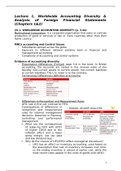Lecture 1, Worldwide Accounting Diversity &
Analysis of Foreign Financial Statements
(Chapters 1&2)
Ch.1. WORLDWIDE ACCOUNTING DIVERSITY (p. 3-44)
Multinational Corporation: is a corporate organization that owns or controls
production of good or services in two or more countries other than their
home country.
MNCs accounting and Control Issues
- Subsidiaries spread across the globe
- Exposure to diferent national systems both in fnancial and
management accounting
- Complexity of accounting and control systems
Evidence of accounting diversity
- Presentation Diferences (Format) page 5-6 in the book. In British
accounting, the accounts are sorted in the reverse order of the
liquidity (non-current assets to current assets; non-current liabilities
to current liabilities; The U.S. order is to the contrary;
- Terminology Diferences (defnition of accounts)
- Diferences in Recognition and Measurement Rules
LIFO: last in frst out, contrast to FIFO.
Consequences of diferences in
recognition and measurement
rules for internal management
decisions: Distortion in Planning,
controlling and performance
management
What are the consequences
of replacing FIFO with LIFO?
(A higher COGS due to the
inflation efect and a lower
gross margin; low tax paid
and low dividend due)
Why do the choices of LIFO/FIFO reflect managerial discretions?
o LIFO has an efect on inventory accounting: used based on
the assumption that cost of inventory increases over time,
so the ending inventory is valued at earlier cost, while the
most recent costs appear in the costs of goods sold (LIFO).
1
, o The company shifts its high-cost inventory costs to costs of
goods sold, this reduces its reported level of proftability
and income taxes (banned except for US).
Sources of Accounting Diversity
INSTITUTIONAL CHARACTERISTICS
1. Legal system
o CODE LAW (continental, civil, legalistic, macro-uniform)
Accounting in law countries is legislated; therefore,
accounting professions have little influence over the
rules (prediscribed format)
Accounting rules tend to be general, opaque with low
disclosure
o COMMON LAW (Anglo-Saxon, British-American, micro-based)
Accounting rules in common law countries are generally
determined by the nongovernment accounting
professions, therefore their accounting rules are more
specifc
Accounting rules in common law countries are
characterized with fair presentation, high transparency
and full disclosure. Common Law characteristics:
(i) There is not always a written constitution or
codifed laws;
(ii) Judicial decisions are binding – decisions of the
highest court can generally only be overturned by
that same court or through legislation;
(iii) Extensive freedom of contract - few provisions are
implied into the contract by law (although
provisions seeking to protect private consumers
may be implied); and
(iv) Generally, everything is permitted that is not
expressly prohibited by law.
Examples of Common Law Countries: The United States,
England, India
Examples of Civil Law Countries: Germany, France, Spain,
Netherlands
2. Taxation
a. In some countries accounting serves for taxation (e.g.
Germany, Poland)
b. If accounting rules or principles align with tax rules;
i. The net income may lose its ability to reflect the
economic reality
ii. There is no need for the account “deferred taxes”
2
,In Germany published fnancial statements serve as the basis for taxable
income. German companies attempt to minimize income for tax purposes
by depreciation, so as to reduce their tax liability. In the US however, tax
statement are only regarding last-in, frst-out (LIFO) inventory costs.
Therefore, German companies are
likely to report lower income than
US.
3. Providers of fnancing
In those countries in which
company fnancing is
dominated by families,
banks or the state, there
will be less pressure for
public accountability than
where companies are
dependent on general
populace.
4. Inflation
o Double or triple inflation render historical cost accounting
useless
o Countries use adjusting accounting records to correct the
distorted accounting numbers in fnancial statements
o Without any adjustments, during inflation periods, in
countries where accounting serves for taxation, companies
will be paying taxes on fctitious profts
5. Political and Economic Ties
a. Accounting is a technology that is borrowed form or
imposed on another country
b. Think of historical events shaping the political arena; e.g.
Colonialism, trade relations.
i. India and UK
ii. Dutch Antilles and The Netherlands
iii. Mexico and US
Problems due to Accounting Diversity
Preparation of consolidated
statements: requires
3
, companies to keep books in local currency using local accounting
principles.
Access to foreign capital markets or fnancing abroad: need to
show fnancial statements.
Comparability of fnancial statement – in terms of understanding
the fnancial performance and situation
Lack of high quality disclosure standards in some parts of the
world
It indirectly contributed to the fnancial crisis in East Asia - the internal
control problems and imprudent management practices were kept were
not visible to the capital providers as a result of failing disclosure.
CULTURE
The influence of culture; culture is also widely considered to influence
accounting systems and their implementation.
Hofstede’s Cultural dimensions:
Individualism and collectivism
Power distance
Uncertainty avoidance
Masculinity
Gray’s accounting values
Gray (1988) derives the theory of accounting sub-cultural dimensions
based on Hofstede. Recognizing accounting values that can be used to
defne a country’s accounting subculture.
Professionalism versus statutory control: a preference of using
individual professional judgement and the maintenance of
professional self-regulation as opposed to compliance with
statutory control
Uniformity versus Flexibiltiy: Uniform accounting processing for
all frms v.s. flexibiltity (The Germany’s case of depreciation
treatment in fnancial and tax accounting)
Conservatism versus Optimizm: cautious measurement to
fnancial performance vs. more opportunistic methods
Secrecy versus Transparency: a preference of confdentiality and
restriction to public disclosures vs. more transparent, open and
publicly accountable approach
The Influence of Culture
4





